
Chassis no. 0384 Engine no. 0384
0384AM was used as factory team car by Umberto Maglioli. The Ferrari factory sold this car to Jim Kimberly in late 1954 after Ferrari had extensively raced it in the 1954 European racing season. Kimberly and Howard Hively raced it extensively in the American and Caribbean SCCA circuits from 1954 to 1957. At the 1957 Cuba GP, car was damaged by fire.
On March 20, 1958, Kimberly sold this car to Karl Kleve, a Cincinnati, Ohio car collector and WWII Manhattan Project scientist. That same Bill of Sale mentions a small under dash fire. While disassembled, stored outdoors in a wooded 2-acre lot, the stripped down chassis, parts of the body, radiator & gearbox stolen (without engine) 0384AM was stolen from Kleve in late 1988 . Kleve passed away in December of 2003, age 90, while still trying to recover his stolen Ferrari.
In 1989 the FBI made arrests. two thieves pled guilty to Interstate Trafficking of Stolen Goods, revealing that 0384AM had been exported. Meanwhile, the stolen portion of Ferrari 0384AM surfaces with Jacques Swaters, Brussels, Belgium via broker Guy Anderson, Atlanta, GA, USA 89-90* – reconstructed in Italy, new block by Nuova Lunelli, Modena, I – identity taken from 0394AM, which was only an engine originally.
Belgium officials impound the stolen portion as “0384AM”. Upon learning of this, Kleve seeks its return. In 1990, mysteriously and despite suspect paperwork with a $4,500 price, the Belgium officials release the impound on 0384AM. Jacques Swaters appears as the purchaser for an alleged price of $100,000.
In 2000, identity changed back to 0384AM*. As of April 2012, the car is under court order the stay at Ferrari HG in Maranello, Modena, Italy till the legal situation still cleared.
In 2013, The court ruled the car be sold at auction and the proseeds to be split between the two parties.
The auction is to held at on 27 Jun 2014, by Bonhams at the Goodwood Festival of Speed Sale
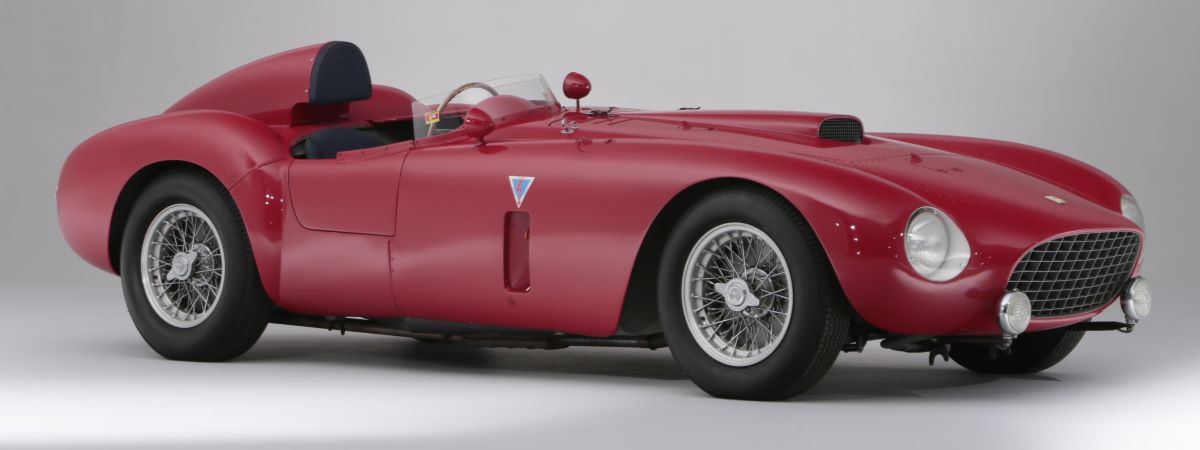
Auction Results
- Sold for: £10,753,500 ($13,657,471.92 USD) on 27 Jun 2014
Footnotes from Bonhams
1954 Ferrari 4.9-litre 375-Plus
Sports-Racing Two-Seat Spider Competizione
Coachwork by Carrozzeria Pinin Farina
Bonhams is delighted to offer here this outstanding example of the biggest-engined, most powerful and most important sports-racing Ferrari model built purely for works team use at the outset of the 1954 International motor racing season.
This is the factory-entered 4.9-litre Ferrari 375-Plus in which Mr Ferrari’s favoured great road racing driver Umberto Maglioli ran second in that year’s mighty Mille Miglia, and seemed poised to overwhelm double-World Champion Driver Alberto Ascari’s factory Lancia D24 before a tuppeny-ha’penny split-pin came adrift within its transaxle gearbox and allowed the final-drive to cease driving, without inflicting any serious further damage…
This is the factory-entered 4.9-litre Ferrari 375-Plus in which the legendary Argentine ace JoséFroilán González obliterated all opposition in the International sports car race supporting the Formula 1 BRDC International Trophy race at th Silverstone May Meeting in Great Britain.
This is also the factory-entered 4.9-litre Ferrari 375-Plus in which the immensely stylish and sophisticated all-Italian driver pairing of Umberto Maglioli and Paolo Marzotto led the Le Mans 24-Hour race that same year.
This great front-engined V12-cylinder sports-racing classic was then sold into private American hands, being campaigned in Sports Car Club of America, Bahamas Speed Week and Cuban events 1955-57 by Kleenex millionaire Jim Kimberly and Howard Hively.
In a later eccentric ownership, the car subsequently fell into disuse and half-forgotten neglect, its original structure and many disparate components surviving despite rather than because of the manner in which its truly extraordinary story developed. Ultimately it was retrieved from such neglect, being painstakingly restored and rebuilt in Italy, its fortunes being revived by Belgian ownership centred upon no less a figure than Jacques Swaters – himself a former Ferrari private owner/driver and for decades Ferrari’s Belgian concessionaire through his illustrious Ecurie Francorchamps organization.
Today, with the restored and running car – reunited with its originally sold-off V12-cylinder engine – accompanied at this Sale by an extensive and immensely significant back-up collection of since-replaced original body paneling, tankage, wheels, brake parts and even period tyres – plus a spare entirely re-made power unit, together with the casting patterns originated for its manufacture – Ferrari 375-Plus ‘0384’ is offered here, “on the button” and ready to run.
This most important Ferrari’s background story begins in the winter of 1953-54. Through that winter Mr Ferrari had recognized that his team would be looking down the gun barrel after two totally dominant seasons of Drivers’ World Championship single-seater Grand Prix racing. Ferrari could not match the sophisticated new 8-cylinder Formula 1 designs from Mercedes-Benz and Lancia, nor even the 6-cylinder 250Fs from Maserati – all of which were poised for introduction that new season of ’54.
Instead Mr Ferrari concentrated his engineers’ attention upon perfecting a line of large capacity sports-racing cars for customer sale, backed by a secondary line of smaller variants, while having his company’s single-seater Formula 2 designs from 1952-53 merely updated with larger 4-cylinder engines for the new season. And to promote and publicise the new sports cars, he approved development of a muscle-bound outsized ‘big bazooka’ for his works team to wield.
The series-production 4.5-litre Ferrari 375 Mille Miglia was to use a V12 engine derived from the 4.1-litre 340 America model series. It retained the 340-type stroke of 68mm was retained, but its bore grew to 84mm to displace 4,522cc. Power output was claimed to be 340bhp at 7,000rpm. The engine was mounted in unit with a 4-speed gearbox which left the completed car with pronounced forward weight bias, and only the variable mass of live axle plus fuel tank out the back. Pinin Farina won Ferrari’s commission to body these cars.
Meanwhile, Mr Ferrari also authorized construction of a handful of very special even larger-capacity works team competition spiders which were intended as his main defence of the Sports Car World Championship title.In the design office Ing, Aurelio Lampredi and his assistants modified the highly-successful old 4.5-litre Formula 1 V12 to accept screwed-in wet cylinder liners, enabling the bore dimension to be increased to the same 84mm as the 375MM. This was then matched with the old F1 stroke of 74.5mm to achieve 4,954cc.
The result would become known by the French racing community as ‘Le Monstre’ and by the British as ‘The Fearsome Four-Nine’. The works car chassis to accept this outsized V12 featured two crucial differences from the 375MM ‘production’ model – an F1-style rear-mounted gearbox in unit with the final-drive, plus de Dion rear suspension in place of a live axle. Strangely, Ferrari claimed only 330bhp, though at 6,000rpm, for this new 375-Plus against the 340 at 7,000 for the off-the-shelf 375MM.
It appears that five of the cars were manufactured for works team use, taking even chassis numbers 0384, 0386, 0392, 0396 and 0398 – all with the familiar ‘AM’ (America) suffix.
On February 28, 1954, ‘Nino’ Farina won easily at Agadir, Morocco, driving the first 375-Plus with Piero Scotti’s 375MM third. The following weekend, both cars contested the Dakar GP in Senegal, which Scotti won once Farina had retired the Plus – after setting a record new fastest lap.
On April 4 the Giro di Sicilia round-Sicily road race saw Umberto Maglioli/Nino Cassani running a lone 375-Plus, Ferrari then claiming 347bhp at 6,800rpm from its 4.9-litre engine. It could be revved to 8,000rpm in extremis. The Girocar was said to weigh only 2,111lbs and to be capable of 186mph…
At the 675-mile race’s first control, in Trapani, Maglioli led Piero Taruffi’s works Lancia D24 V6 by 67secs. Two hours later, at Agrigento, Taruffi led Maglioli by 1min 58secs. But after four hours’ racing, at Enna, Maglioli led the entire Lancia team by nearly 3mins 30secs.
Mr Ferrari rated young Maglioli highly, regarding him years after as “…a very fast long-distance racer, as well as being a capable and serious man, willing to face the difficulties of any course, any distance – he kept his position on the team as a safe, reassuring asset”.By Mr Ferrari’s standards this is a paean of praise, despite Maglioli’s luck running out in Sicily as he rolled the 375-Plus just after the Enna control and service depot. Taruffi was left unchallenged to win the Giro for Lancia.
Italy’s all-important Mille Miglia followed on May 1. The 375-Plus engines’ power curve had been improved, maximum torque boosted by some 10 per cent, unleashing extra mid-range power and drivability – 315lbs/ft torque increased to 348lbs/ft, with an additional 25bhp mid-range.
But in the dark, damp, small hours Farina crashed his race-favourite 375-Plus soon after the start at Peschiera, bouncing off a concrete post and smashing into a tree. He broke his arm and nose, passenger Luigi Parenti his leg and pelvis. The car was so badly wrecked its identity was scrapped.
Maglioli in the surviving works 375-Plus (‘0384 AM’ offered here) and his team-mate Paolo Marzotto’s 375MM then ran 4th and 5th as three works Lancias danced away on the rainswept roads. Maglioli inherited third place when Castellotti’s and Taruffi’s Lancias failed. Before the Florence control Paolo Marzotto’s 375MM retired with gearbox trouble but Maglioli found himself well placed in ‘0384AM’ headed only by Ascari’s Lancia. While Ascari’s time to Florence was 8hs 22mins 18secs (averaging 86.8mph after 729 miles of wet-weather road racing) – Maglioli’s in the surviving Ferrari 375-Plus had been 8:27:25.
Umberto Maglioli recalled how he was in good shape, and poised to go for victory on the straight, flat-out final section from Bologna to Brescia, where the ‘Four-Nine’ could catch and overwhelm the little Lancia: “There it was very good, but the problem was always that it was so impossible to stop the car, and therefore to relax at any stage. We believed there was always the danger that a tyre could blow. The rear-mounted gearbox was taken from the 4.5-litre Formula 1 and the larger 4.9-litre engine put it in danger… due to the extra torque. I was careful always to accelerate gently, not to overstress the gearbox, nor the tyres.
“I was feeling fairly confident that on the flat, fast final section from Bologna to Brescia the great power of the Ferrari would give me five or ten minutes’ advantage over Ascari. I knew I had a strong chance of winning at that point as we crossed the Raticosa Pass…
“Then as I was thinking this, I just accelerated at one point and the engine roared and the car did not accelerate. It was slowing down, and there was no connection to the rear wheels.A split-pin had fallen out, a pinion bearing came loose and the gearwheels moved out of mesh. I just abandoned the Ferrari in a peasant’s yard far out in the remote countryside, and eventually drove down to Bologna in a private car…
“It was a great disappointment, but in motor racing we were all well accustomed to disappointment.”
Left unchallenged, Alberto Ascari won the Mille Miglia comfortably for Lancia, ending a string of six consecutive Ferrari victories in the Mille Miglia.
Ferrari ‘0384AM’ offered here was then retrieved from its rural refuge, and with its final-drive easily repaired at Maranello it was trailered two weeks later to Silverstone, England behind the Ferrari factory team transporter carrying the sister Formula 1 entries. Lead driver was to be the spectacular Argentinian JoséFroilán González in the 17-lap (50-mile) sports car race supporting the Formula 1 ‘Daily Express’ International Trophy at the BRDC May Meeting.
The British press was spellbound by the roly-poly Argentine’s spectacular driving and searing pace, for at Silverstone he showed it all. The British journalists nicknamed González ‘The Pampas Bull’. He certainly charged around Silverstone to tremendous effect, not only dominating the sports car race by leading virtually from start to finish in the ‘0384 AM’ but also winning both his Formula 1 race Heat in his factory Ferrari ‘Squalo’ and the 35-lap Final in a substitute Ferrari 625 to make it a hat-trick of wins that day in May.
He also set fastest Formula 1 lap at 95.79mph (in the 625) while in the 375-Plus he had averaged 83mph on a damp and treacherous track. His fastest lap in ‘0384’ was 85.68mph,137,872 km/h. He lapped the last-placed of the 27 starters three times, and by chance as he passed the pits to complete his 16th lap ‘0384 AM’ was completely alone on the Silverstone track…
Fully 15 seconds of eery silence then passed before driver/constructor George Abecassis came blaring through in his second-placed HWM-Jaguar. ‘The Fearsome Four-Nine’ had just eaten all its rivals alive.
The 1954 Le Mans 24-Hour race followed. Maglioli and Paolo Marzotto co-drove this Silverstone-winning ‘0384AM’ while González/Maurice Trintignant and Louis Rosier/Robert Manzon handled sister ‘Four-Nines’. British journalist Gregor Grant of ‘Autosport’ wrote: “The big 4.9-litre cars came to the Sarthe with a dreadful reputation for handling properties. Stories were freely circulating that drivers were averse to piloting them, and that it was as good as signing their death warrant to go to Le Mans.
“Admittedly they are brutal-looking devices, but one could scarcely believe that the genius who has been responsible for the development of the wonderful Ferrari racing cars, would risk the lives of drivers with a dangerous contraption.
“Paolo Marzotto admitted that, at first, the cars are terrifyingly fast, but constant practice made them as easy to control as any modern sports-racing car…
“Watching them in action, it was obvious that the more experienced drivers, such as González and Trintignant, preferred to use the ‘slow in, fast out’ method of cornering, and not to risk using up their brakes to try to save seconds. They were perfectly aware that they could out-accelerate anything on the circuit, and that they could match the better streamlined (D-Type) Jaguars for sheer maximum speed on the straights.”
Paolo Marzotto ran second in ‘0384 AM’ during the opening stages of the great race, as González led from the young Italian with Manzon’s sister works 375-Plus third.
‘The Autocar’ reported how: “Gonzalez, lights on to encourage the slower cars to give room, tore past the stands on the outside of the slight bend, cut across fairly quickly and took the right-hander under the Dunlop Bridge about eighteen inches from the side line, exhaust crackling until his foot went down again; the Ferrari was rock-like in its steadiness. Tony Rolt’s Jaguar was equally impressive, his line under the Bridge being one long, beautiful swerve (while) Marzotto was carving closer in, pulling his Ferrari over immediately after the crisp down-change for the bend.”
Young Marzotto then moved this Ferrari, race number ‘3’ into the lead, swopping first place to-and-fro with team leader González as rain began. At the end of the second hour’s racing González/Trintignant’s 375-Plus led the Marzotto/Maglioli car with the Stirling Moss/Peter Walker Jaguar D-Type third. On lap 27 Marzotto regained the lead and when he eventually stopped to refuel he rejoined without handing over to his senior co-driver Maglioli. Problems striking the works Jaguars then left the Ferrari fleet in full control. After four hours the Ferrari 375-Plus trio were circulating 1-2-3 – González, Marzotto and Robert Manzon. Although the rain was abating, the track remained slick and treacherous.
Into that brief mid-summer night Ferrari’s domination continued until, after seven hours, the ‘0384AM’ was out with a gearbox failure. The Rosier/Manzon car also succumbed to gearbox breakage, but after a classic battle between the surviving González/Trintignant Ferrari and its Jaguar D-Type counterpart crewed by Tony Rolt/Duncan Hamilton Ferrari would score sensational victory. The big, brutal, beautiful, baritone 375-Plus had won sports car racing’s biggest prize of all…
The ecstatic González began telling every journalist who would listen how these 375-Plus cars were “….lighter than they look” and maintained that they were also remarkably stable, even with their vast fuel load. Their ZF differentials gave them a real advantage on the wet roads, enabling the drivers to make full use of their stunning acceleration while the wet surfaces also solved the problem of tyre wear which would have posed daunting difficulties had the weather been dry and the road surface hot.
Paolo Marzotto described how during the night in ‘0384AM’ he had been given a “slower” signal and consequently backed off down the Mulsanne Straight from around 170mph to 145-150. This he found remarkably boring, making him grow more and more sleepy. On one occasion his eyes snapped open just in time to find the Mulsanne Corner looming up. He exclaimed “I awake so quick I nearly fall out of the car!”.
These fearsome ‘Four-Nines’ were not run again by the Ferrari factory, but for the five-day Carrera PanAmericana in Mexico – final round of 1954’s FIA Sports Car World Championship – Ferrari’s American agent Luigi Chinetti arranged indirect sponsorship on the basis of finding private customers to buy ‘the works entries’. Mr Ferrari agreed, providing Umberto Maglioli would drive one 375-Plus.
He won in the ex-Rosier/Manzon Le Mans sister team car ‘0392AM’ which Chinetti had arranged to sell to American owner/driver Erwin Goldschmidt.
Young American Phil Hill in Allen Guiberson’s 4.5-litre Ferrari 375MM provided Maglioli’s main opposition. But the 375-Plus prevailed. On the long 186-mile stage from Parral to Chihuahua Maglioli averaged a staggering 127mph. Overall, Maglioli won that five-day 1954 Carrera by completing the 1,908-mile distance at an average speed – on 1954-standard Mexican public roads – of 107.96mph.This phenomenal performance vividly emphasizes just how well Ferrari had perfected their big ‘Plus’ by the end of that 1954 season.
‘Our’ car, ‘0384 AM’ ex-Maglioli Mille Miglia and González’s Silverstone winner, was bought via Chinetti by Kimberly-Clark company ‘Kleenex’ millionaire Jim Kimberly,of Chicago, Illinois. He had been racing a 375MM before adding the ‘Four-Nine’ to his private Scuderia. On February 21, 1955, he set second-fastest time on Daytona Beach and six days later placed second again in an airbase race at Fort Pierce, Florida. He co-drove the car with Ebby Lunken in the 1955 Sebring 12-Hours, going well before retirement, then ceded the car to his friend Howard Hively, a Cadillac dealer in Cincinatti, Ohio. He won in ‘0384AM’ at Lawrenceville, Kansas, in June and both Hively and Charlie Hassan won races in the car at St Joseph, Missouri, that July.
Hively hammered home sixth in the major Road America ‘500’ at Elkhart Lake, and shipped the car to the Bahamas Speed Week that December, but without notable success. The big Ferrari reappeared in the 1956 Sebring 12-Hours, Hively co-driving with Indy star Troy Ruttman only to encounter gearbox problems. On February 25, 1957, with the car resplendent in white, blue and red livery, Howard Hively contested the Cuban Grand Prix on the Malecon highway circuit in Havana.
On March 20, 1958, Hively sold the then-obsolescent Ferrari – on Kimberly’s behalf – to fellow Cincinatti resident, Karl Kleve, for $2,500. Kleve collected old and interesting cars – and the occasional aircraft – and enjoyed converting, uprating and generally tinkering with them. He may have planned to replace the Ferrari’s big V12 engine with a stock V8, but time passed – other projects took precedence and ‘0384’ languished on a trailer, abandoned outdoors on one of Karl Kleve’s woodland properties, just outside Cincinatti. The old car’s V12 engine, at least three of the huge drum brakes, and the engine cover, boot lid and doors had been removed, becoming buried for years amongst other detritus in one of his barns. The cockpit area paneling suffered localized burn damage, said to have been caused by a cockpit wiring fire. Meanwhile the denuded chassis and main aluminium body sat outside, in sun, rain and snow…and its rear end, especially, began to corrode…
Around 1970 Karl Kleve sold the original V12 engine to GM engineer Fred Leydorf. The years rolled on, with ‘The Fearsome Four-Nine’ still languishing on Kleve’s woodland lot, a sapling tree first sprouting then maturing through its empty engine bay.
On or about January 13, 1989,this car was removed– unbidden – from Kleve’s land. It was taken down into Georgia, whenceit was acquired by a French buyer, one ‘Giles Christian’ for $50,000. As early as that February the frame and surviving attached body were shipped to Antwerp, Belgium, bound for Michael Kruch’s L’Exception Automobile concern. In America Karl Kleve had reported the car stolen, and the Belgian authorities impounded it to investigate. They concluded it had been bought in good faith and that its European title was sound. In February 1990 the car was released and sold the following month to veteran racer and Belgian Ferrari concessionaire Jacques Swaters in partnership with enthusiast Philippe Lancksweert.
While litigation triggered by its extraction from Karl Kleve’s tenure ensued within the US, ‘0384 AM’ has remained in Europe ever since. Messrs Swaters and Lanksweert had it gleamingly restored in Modena, under the supervision of respected former factory Assistenza manager Gaetano Florini. The corroded original body paneling was carefully removed and preserved, rusted sections of the chassis – most notably at the long-exposed rear – were removed, replaced but also kept and accompany the Lot now offered here. Respected local Ferrari specialists Bachelli& Villa rebodied the car and a fresh V12 engine to the correct spec was assembled and installed. Swaters showed the car in Brussels and at Spa in 1992 and – most importantly – reached a settlement with Karl Kleve in the US.
Philippe Lanksweert ran this sparklingly restored ‘Four-Nine’ in selected Historic events into ‘the noughties’ and it was displayed at the Ferrari factory’s Galleria Ferrari in Maranello.
On December 24, 2003, Karl Kleve died, aged 90. His daughter Kristine Kleve Lawson fell heiress to the stored stack of parts long-removed from ‘0384 AM’ and not taken at the time of the car’s removal from its Cincinatti incarceration.An unfortunate dispute then developed between her and Jacques Swaters who really wanted to reunite these parts with the restored car. He was, however, able to buy the original 4.9-litre V12 engine from Fred Leydorf and it is back in the car today, with the 1990s NuovaLunelli-block replacement unit set aside but retained as a hugely valuable spare.
The situation between Jacques Swaters and Kristine Kleve and her American advisors ebbed and flowed during this period, becoming a legal dispute in 2010. Jacques Swaters – himself a towering figure within the Ferrari world – died that December, and ‘0384 AM’ was inherited by his daughter Florence.
She invited Bonhamsto assist, in part to help mediate between the Belgian and American parties and – if litigation could be settled – to sell the car by auction for mutual benefit. As in several other instances over many years, Bonhams has been successful in bringing these parties together.
Today – with all relevant litigation settled – this magnificently presented ex-González Silverstone-winning, ex-Maglioli Mille Miglia and Le Mans works Ferrari is now poised to enter a caring new ownership. It is accompanied by all the once Kleve-removed original components, its 1954 works team body paneling – still in Hiveley’s 1957 Cuban GP livery – engine cover, bootlid, spare brake drums, numerous original Borrani wire wheels (still shod with contemporary tyres), all the excised corroded chassis tubes, the late-replacement V12 engine, and even the numerous casting patterns used in that unit’s manufacture.
In period the Ferrari 375-Plus was the most powerful and fastest factory team projectile in World Championship contention.
It proved its pace, stamina and ultimately well-developed handleability by winning not only the Le Mans 24-Hours but also – at record-breaking pace – the Carrera PanAmericana through Mexico. Umberto Maglioli and Paolo Marzotto were both patrician ‘Mr Cools’ who handled ‘0384AM’ while Froilan González, the near-spherical little ‘Pampas Bull’ was the really muscle-packed totally ‘speed-happy’ hero who hurled the car round Silverstone to win both there, and in the sister car that same year, at Le Mans.
So here is a classical front-engined factory Ferrari handled in period by truly charismatic top-line drivers – and one whose ex-works story is jam-packed with astounding eccentricity, sometime mystery and now completely resolved intrigue…
We recommend the closest inspection, and consideration. And from personal experience we can confirm that today this thunderous ‘Four-Nine’ drives every bit as impressively as it looks.
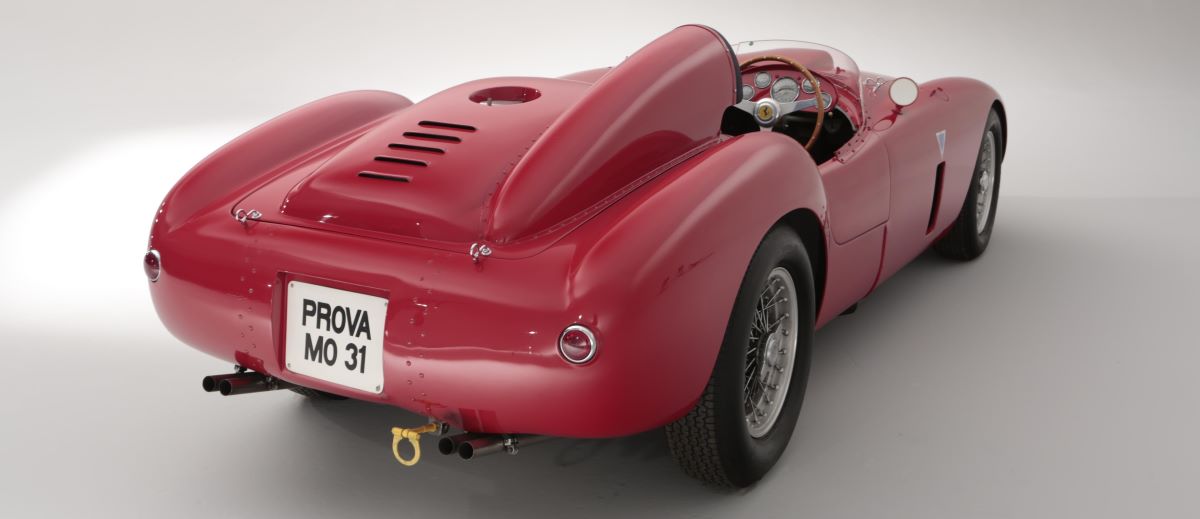

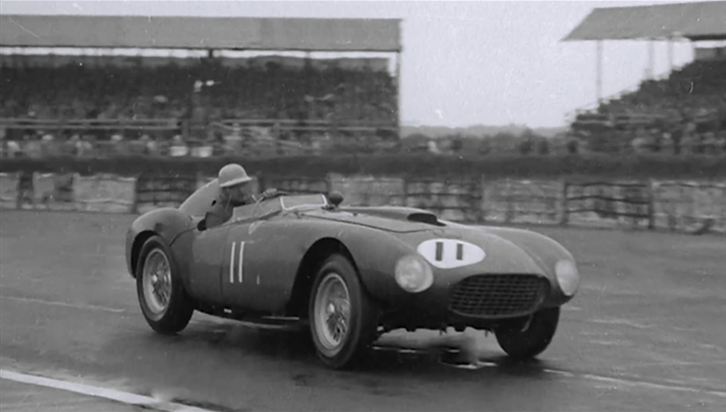
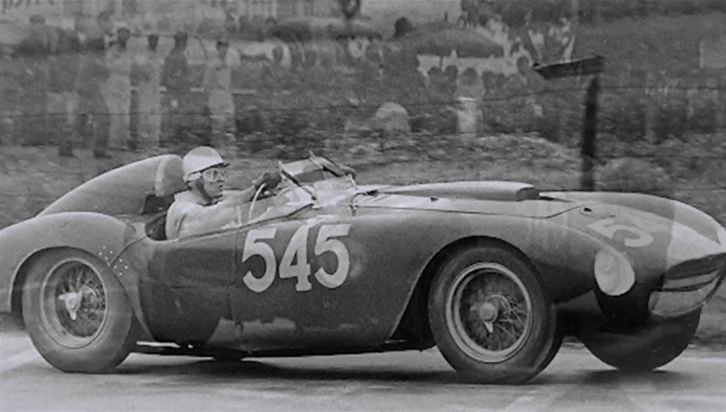
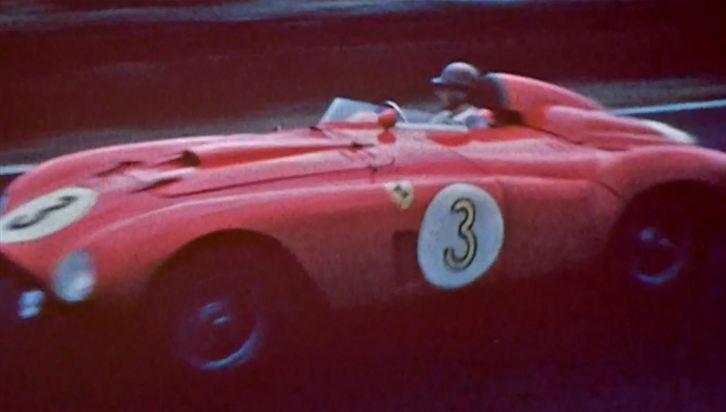
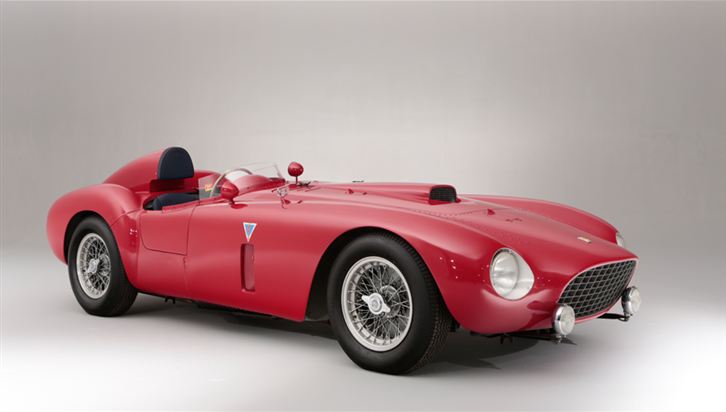
You must be logged in to post a comment.